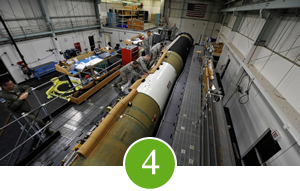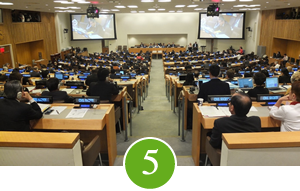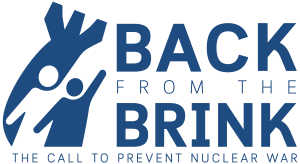OUR FIVE POLICY SOLUTIONS
We call on the United States to lead a global effort to prevent nuclear war.
Renounce the Option of Using Nuclear Weapons First
The United States has never renounced the right to use nuclear weapons first. This increases the chance that a conflict could escalate to nuclear war. The United States should instead declare that it will never be the first to use nuclear weapons.
The Obama administration narrowed the role of nuclear weapons by stating that the US would not use or threaten to use nuclear weapons against any country without nuclear weapons that was in compliance with its nuclear nonproliferation obligations.
But it stopped short of declaring that the sole purpose of US nuclear weapons was to deter the use of nuclear weapons. Instead, it cited “a narrow range of contingencies” in which US nuclear weapons might be used: to deter an attack on the US or its allies using conventional, chemical, or biological weapons by a state that possessed nuclear weapons or was not in compliance with its nonproliferation obligations.
The Trump administration’s recent Nuclear Posture Review broadens the range of scenarios that might lead to the first use of US nuclear weapons. These, it says, “include, but are not limited to, attacks on the U.S., allied, or partner civilian population or infrastructure, and attacks on U.S. or allied nuclear forces, their command and control, or warning and attack assessment capabilities.”
Substantially broadening the range of circumstances under which the United States would consider the first use of nuclear weapons is a step in the wrong direction. It makes a nuclear war more likely by reducing the threshold for nuclear use. Retaining the option to use nuclear weapons as part of a preemptive or preventive strike, or in response to conventional, chemical, biological, or other types of weapons creates a dangerous uncertainty. It makes it more likely that an adversary facing the threat of US nuclear weapons use may decide that it needs to be the first to take this step. Given the overwhelming strength of its conventional military, the United States has nothing to gain from escalating a conflict to the nuclear level. Indeed, the United States and the world have everything to lose.
The United States should declare that it will never be the first to use nuclear weapons, and would use them only in response to a previous nuclear attack. Of course our goal is the complete elimination of nuclear weapons, but as long as they exist, a “no first use” declaration would reduce the likelihood that tensions or conventional conflict with another nuclear-armed state would escalate to nuclear use.
HR921/S272 The bicameral No First Use Act, introduced by Representative Adam Smith and Senator Elizabeth Warren in January 2020, would establish in law that it is the policy of the United States not to use nuclear weapons first. If this bill were to become law, it would officially accomplish the first policy step of Back from the Brink, so we encourage everyone to contact their members of Congress and encourage them to cosponsor the bill.
Learn more about the bill and see lists of cosponsors:
Organizations that have action alerts to contact representatives to encourage cosponsors:
Tell Congress: The United States Should Never Start a Nuclear War
Tweets by the Legislative Cosponsors on One Year Anniversary of the Bill Introduction:
Read the press release by the cosponsors on the initial introduction of the bill in January of 2019:
Chairman Smith, Senator Warren Introduce Bill Establishing “No First Use” Policy for Nuclear Weapons
“We know that the use of a fraction of the global nuclear weapons arsenal would have devastatingly, irrevocable consequences to our planet and that a national defense strategy based on nuclear armament decreases, rather than increases, our national security.”
Robyn Gabel
Illinois State Representative
RELATED INFORMATION
Voters Strongly Support a “No First Use” Nuclear Policy Polling in New Hampshire, Iowa, Michigan, Ohio, South Carolina, and Georgia found that there is strong support for a No First Use policy.
US Military Options Should Not Include Starting a Nuclear War This fact sheet explains the security benefits of a No First Use policy and how it would make the United States safer.
Fact Sheet on No First Use of Nuclear Weapons This fact sheet gives an overview of the No First Use policy with references to the medical and financial costs of the current policy which allows for the US to start a nuclear war.
“No First Use” Talking Points This fact sheet explains how the “No First Use Act ” in the House (H.R. 921) and Senate (S. 272) if passed, they would reduce the likelihood of nuclear war and be a step in the direction of global disarmament. It also includes quotes from the legislative cosponsors Rep. Adam Smith and Sen. Elizabeth Warren, as well as Former Defense Secretary Bill Perry, who served under President Clinton and Former Vice President Joseph Biden.
A Modest Proposal: Don’t Start a Nuclear War: No one wants a nuclear war, ever. Why don’t we have a policy against starting one? This article gives an overview of the current state of our first strike policies and explains why it is important that the US adopts a policy of No First Use.
End the Sole, Unchecked Authority of Any U.S. President to Launch a Nuclear Attack
Currently there is no check on the president’s authority to order the use of nuclear weapons, either first or in response to a nuclear attack. If the president decided to launch a nuclear strike, he/she would simply notify the military of this decision. The president may consult advisers, but this is not required, and no one has the authority to countermand a legal launch order. This system is risky and unjustified. There are practical ways to include multiple decision-makers in authorizing the use of nuclear weapons, and the United States should adopt such changes.
Presidential sole authority is an artifact of the Cold War, when the greatest fear was a massive bolt-from-the-blue first strike by the Soviet Union that would wipe out the United States’ missiles before it had a chance to retaliate. But this system is risky and unjustified; no single individual should be able to make such a momentous decision. There are practical ways that the process can be changed to include multiple decision-makers in authorizing the use of nuclear weapons, and the United States should adopt such changes.
“Do any of us really think that the decision to destroy life on earth as we know it should rest with only one person? America was built on the idea that power should not be concentrated in any one person because we are all fallible. The president, by current policy, has the authority to launch nuclear weapons.”
Joseph McCabe, M.D.
Needham, MA
Back from the Brink resolution adopted May 2019
RELATED INFORMATION
Three Heads Are Better Than One: How to Limit the President’s Single-handed Authority to Order the Use of Nuclear Weapons This fact sheet provides an alternative plan to end the sole authority of the president by utilizing the Federal Emergency Management Agency tracking and communication system to require consent from more people than just the president.
Defense Primer: Command and Control of Nuclear Forces Congressional Research Service This fact sheet gives an overview of the Nuclear Command and Control System and Options for Nuclear Use.
The United States has roughly 1,700 deployed nuclear weapons and another several thousand in reserve. Four hundred of these are on missiles in underground silos, ready to be launched within minutes of a presidential order. This alert status — called hair-trigger alert — increases the chance of a launch in response to a false alarm. There have been numerous close calls over the past forty years due to both human and technical errors, and keeping missiles on high alert increases the danger of accidental war. There is no compelling rationale for maintaining this option. The United States should remove its missiles from hair-trigger alert.
This risky alert status, coupled with the option of ordering a launch based on warning of an incoming attack, increases the chance that a nuclear war could start due to a false alarm or other error. Maintaining hair-trigger alert options leads to unnecessarily rushed decision making. A land-based missile can travel between Russia and the United States in about 30 minutes, and a submarine-launched missile could take as little as 10 to 15 minutes. After receiving warning of an attack, military and political leaders would have only minutes to assess the credibility of this information and decide how to respond. This time pressure increases the danger of ordering a launch based on faulty information, and over the past forty years there have been numerous examples of close calls due to computer or human error.
Hair-trigger alert is an outdated policy — the original rationale was the fear during the Cold War that either side could launch a surprise first strike that might wipe out its adversary’s ability to retaliate, which at that time largely consisted of land-based missiles and bombers. Today such an attack is exceedingly unlikely, but even if the worst were to happen, the United States now deploys more than 1,000 nuclear warheads on submarine-based missiles, hidden at sea. These sea-based missiles are not under the same pressure to be launched quickly as land-based missiles, and ensure that the United States would still be able to launch a retaliatory strike.
There is no compelling reason to maintain US missiles on hair-trigger alert, and many reasons not to. Taking land-based missiles off high alert and removing rapid-launch options from US nuclear plans would reduce the risk of nuclear use.
“The threat of nuclear disaster is real. And a culture of violence as a means of problem-solving is also very real.”
Leslie Castellano
Eureka City Councilmember
Back from the Brink resolution adopted April 2019
RELATED NEWS & INFORMATION
I Wish I Didn’t Know That: Real-Life Tales of Close Calls, Screw Ups, and Nuclear Near Misses This UCS interactive Wheel of Nuclear Misfortune highlights some of the terrifying stories of nuclear weapons accidents that have occurred throughout the world.
Reducing the Risk of Nuclear War: Taking Nuclear Weapons Off High-Alert This UCS report explains the Cold War origins of high-alert policies, the dangers of these policies, close calls throughout history, and the benefits of taking land-based nuclear missiles off high alert and removing rapid-launch options from nuclear war plans.
Frequently Asked Questions about Hair-Trigger Alert This UCS fact sheet answers questions such as, What does it mean to say that nuclear missiles are on hair-trigger alert? Why would taking missiles off hair- trigger alert increase our security? How would the United States take missiles off hair-trigger alert?
Over the next 30 years, the United States plans to spend an estimated $1.7 trillion dollars to replace its entire nuclear arsenal and the bombers, missiles, and submarines that delivers the weapons with more capable versions. Such a tremendous investment of money and effort is unnecessary. The U.S.’s current nuclear arsenal is more than sufficient to deter an attack (and indeed sufficient to destroy life on this planet as we know it many times over), and the conventional military deterrent is also sufficient to not need additional nuclear weapons or upgrades.
It also sends a counterproductive message to the rest of the world by making it clear that the United States continues to see its nuclear arsenal as central to its security and intends to keep it for the foreseeable future. This will only encourage other states to believe that they also need to develop or improve their own nuclear arsenals, leading to dangerous proliferation and an accelerating arms race.
Instead, the United States should deemphasize the importance of nuclear weapons in its security policy as it works with the other nuclear armed states to eliminate these weapons altogether.
“Over the next 30 years, our country plans to spend an estimated 1.7 trillion dollars to replace its entire nuclear arsenal. This is madness. You know it. I know it. The whole world knows it.”
Reverend Robert Oldershaw
Evanston, IL
Back from the Brink resolution adopted Jan. 2020
RELATED INFORMATION
An Unanswered Question at the Heart of the U.S.’s Nuclear Arsenal: Nobody knows how long the plutonium “pits” in the cores of bombs last, and the answer could cost—or save—billions blog post by Stephen Young of UCS. This blog post explains the lack of information we have about the lifespans of plutonium pits, which are at the core of all US nuclear weapons.
The High Risks of Low-Yield Nuclear Weapons UCS Podcast episode In this episode, Dr. Lisbeth Gronlund, Co-Director of the Global Security Program at the Union of Concerned Scientists, explains the capabilities of the US nuclear arsenal and why smaller-scale nuclear weapons are just as dangerous as bigger bomb.
The New “Low-Yield” Submarine-based Nuclear Warhead UCS Report This report explains the ways that the W76-2 nuclear warhead, which was deployed in early 2020, makes nuclear war more likely.
US Deploys New Low-Yield Nuclear Submarine Warhead Blog post by FAS
Pursue a Verifiable Agreement Among Nuclear Armed States to Eliminate their Nuclear Arsenals
Given the extraordinary destructive power of nuclear weapons, it should be the highest US national security priority to seek the elimination of these weapons — those possessed by other countries and those in our own arsenal.
Even our own nuclear weapons pose an existential threat to our survival. Recent studies have shown that the use of any significant portion of our nuclear arsenal against cities, even against an adversary who never fired back, could cause worldwide climate disruption and global famine. The United States needs to initiate negotiations with all of the nuclear weapons states on a verifiable agreement to eliminate these weapons.
The United States — like Britain, China, France and Russia — is already obligated under Article VI of the Nuclear Non-Proliferation Treaty (NPT) to take concrete steps toward eliminating its nuclear arsenal. Nations that joined the NPT as non-nuclear-weapons states, pledging that they would not develop their own nuclear weapons, did so in part on the basis of this promise of disarmament. These states have become increasingly frustrated at the lack of progress among the nuclear weapons states toward meeting their treaty obligations.
One response to this frustration was the negotiation of the Treaty on the Prohibition of Nuclear Weapons, which was approved in July 2017 by 122 states and has so far been signed by more than 50. The treaty is modeled on existing treaties outlawing other types of weapons considered inhumane, such as biological and chemical weapons, land mines, and cluster munitions, and makes it illegal under international law to “develop, test, produce, manufacture, otherwise acquire, possess, or stockpile nuclear weapons or other nuclear explosive devices.”
The United States refused to participate in the negotiating process. Such an attitude will not serve it well in the long run. But it should recognize reality and live up to its responsibility to begin negotiations on a staged approach that would end in the verifiable elimination of all nuclear arsenals.
“August 6, 1945. The sky was covered with the blue light. The atomic bomb exploded over the city of Hiroshima. 130,000 people disappeared. One scene I cannot forget is the little black bundle of a baby and the mother was still hanging on to this little thing. Many people suffered radiation sickness. Today, 73 years later some of the atomic bomb survivors are still suffering with cancer, leukemia, and the radiation sickness. We must abolish the atomic and nuclear weapon so no one will ever use it again on human beings. We must pursue the peace of the world.”
Junji Sarashina
President, American Society of Hiroshima-Nagasaki A-Bomb Survivors
Los Angeles, CA
Back from the Brink resolution adopted Aug. 2020







